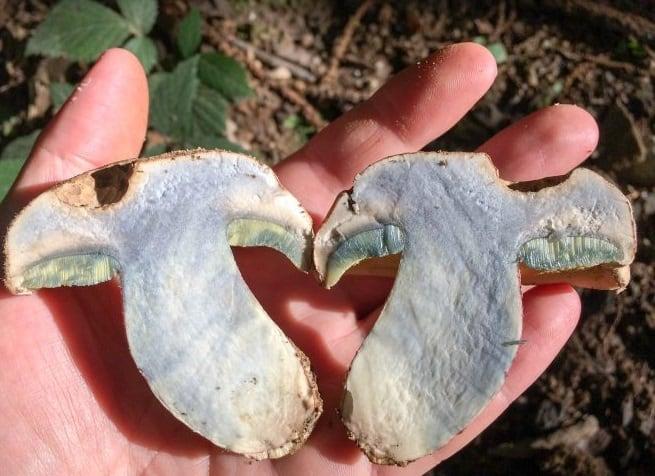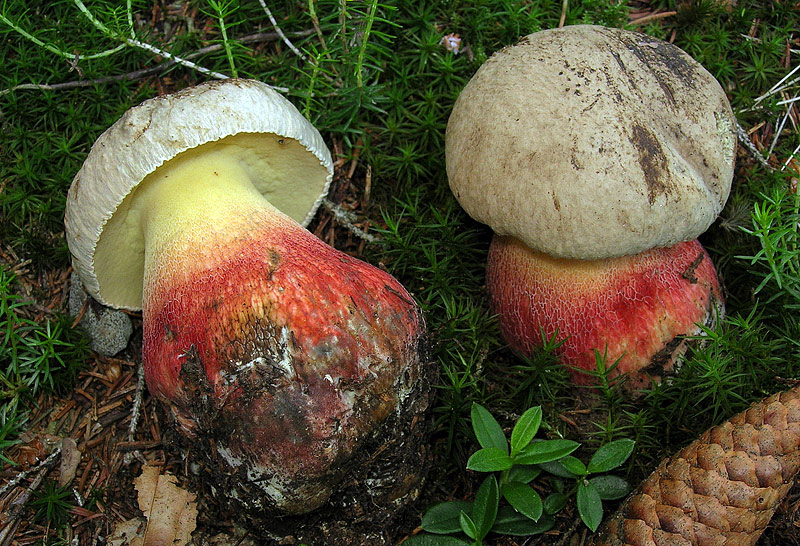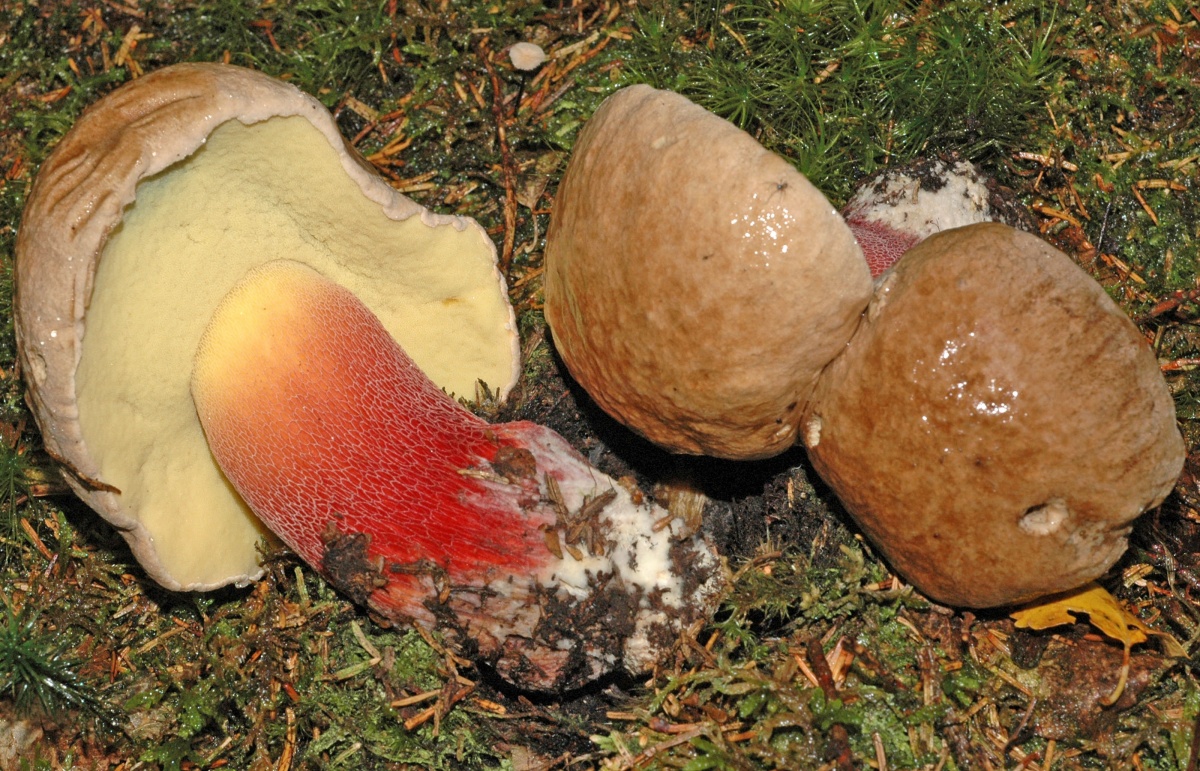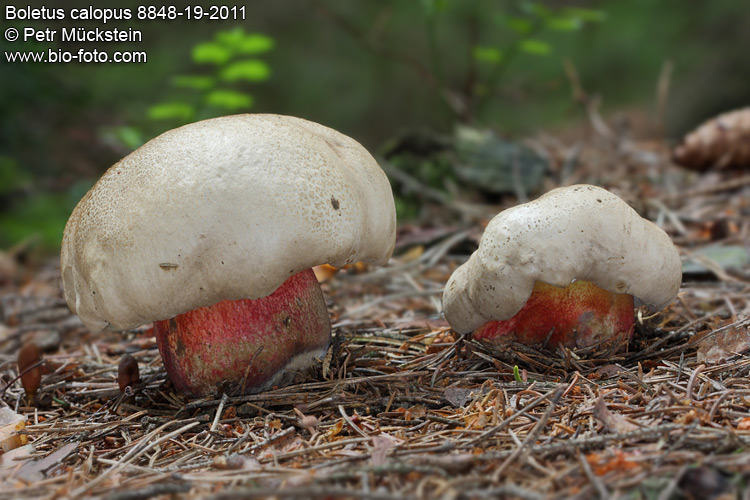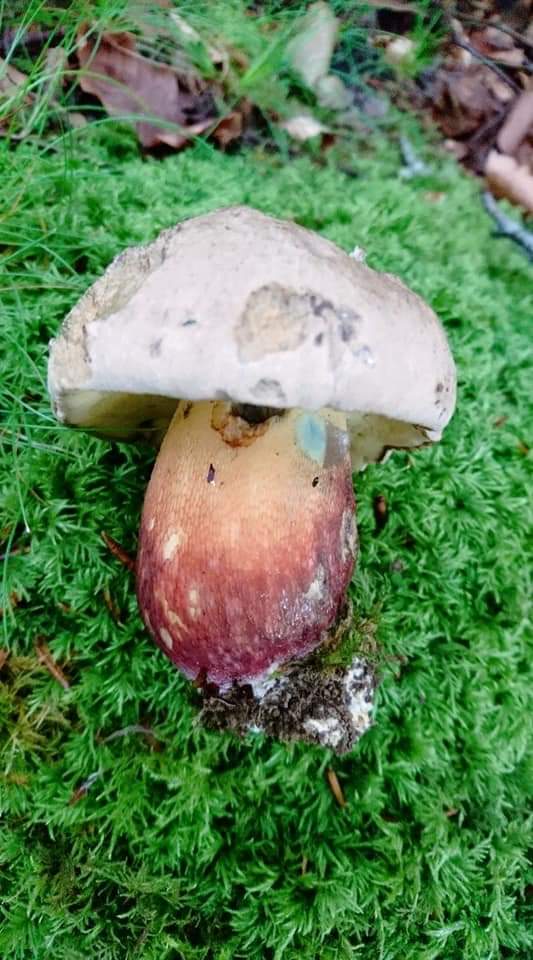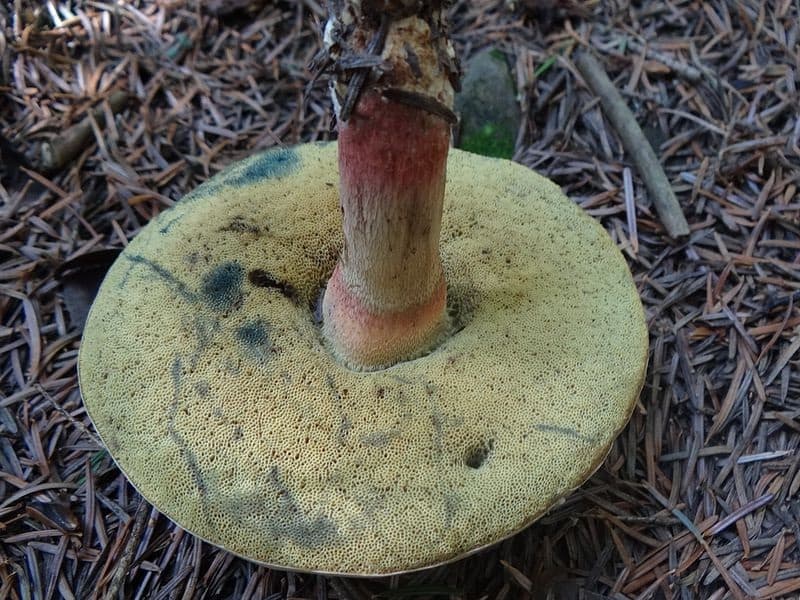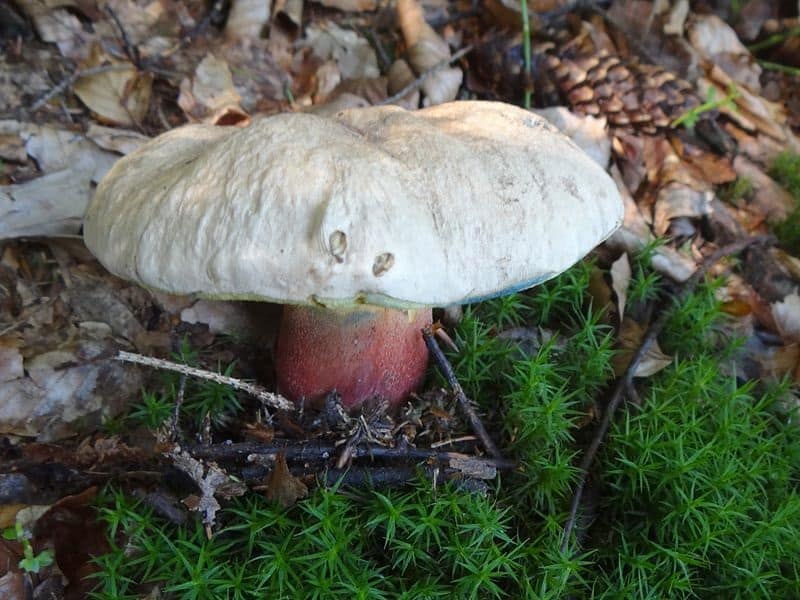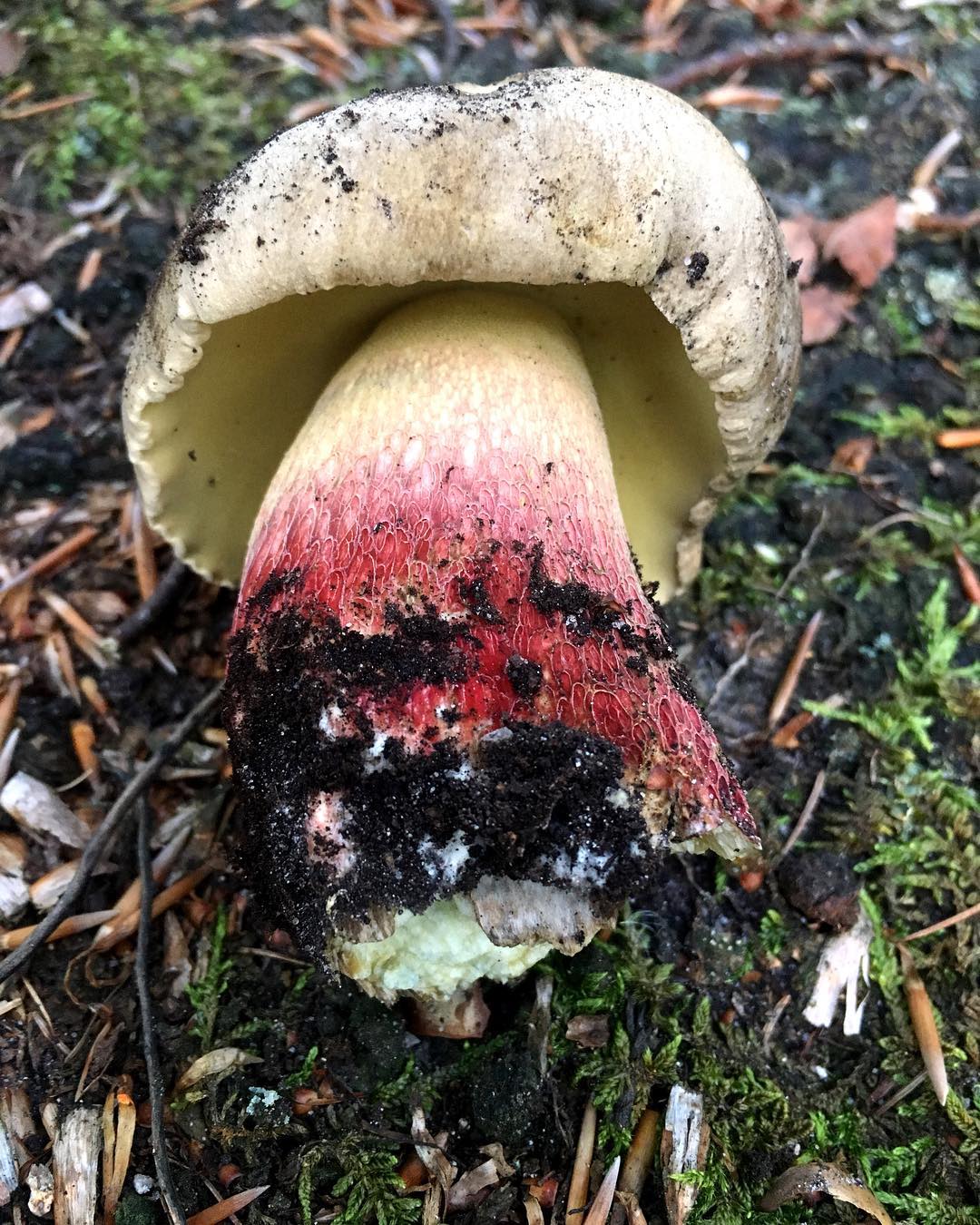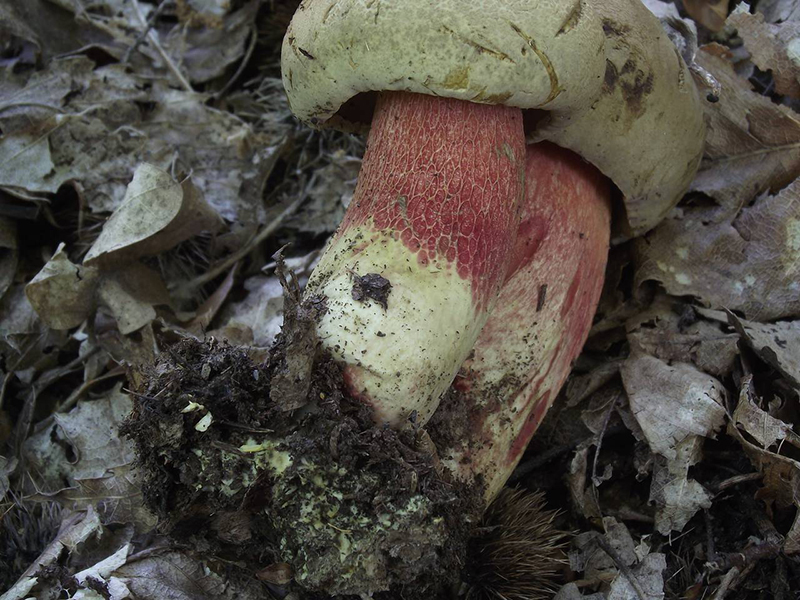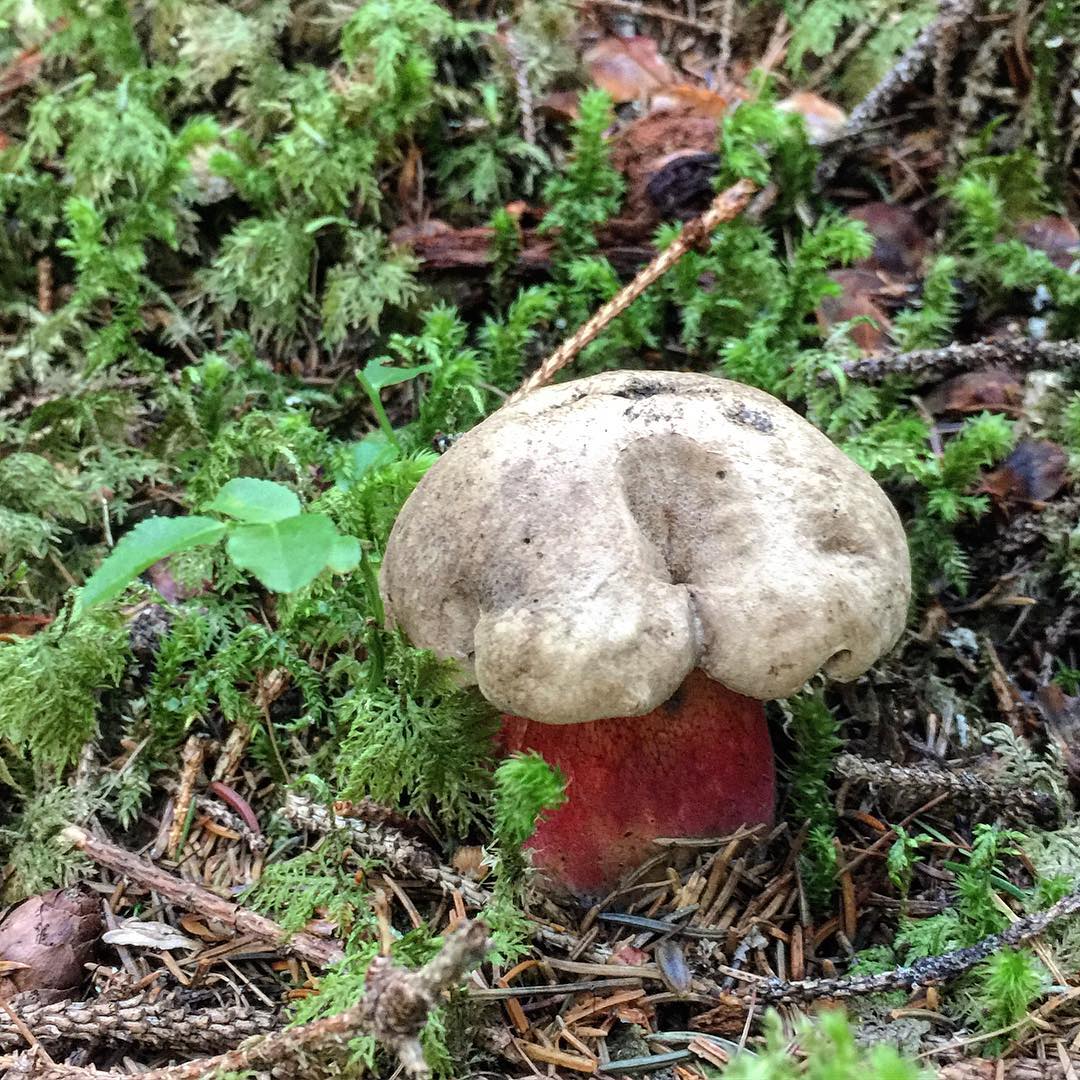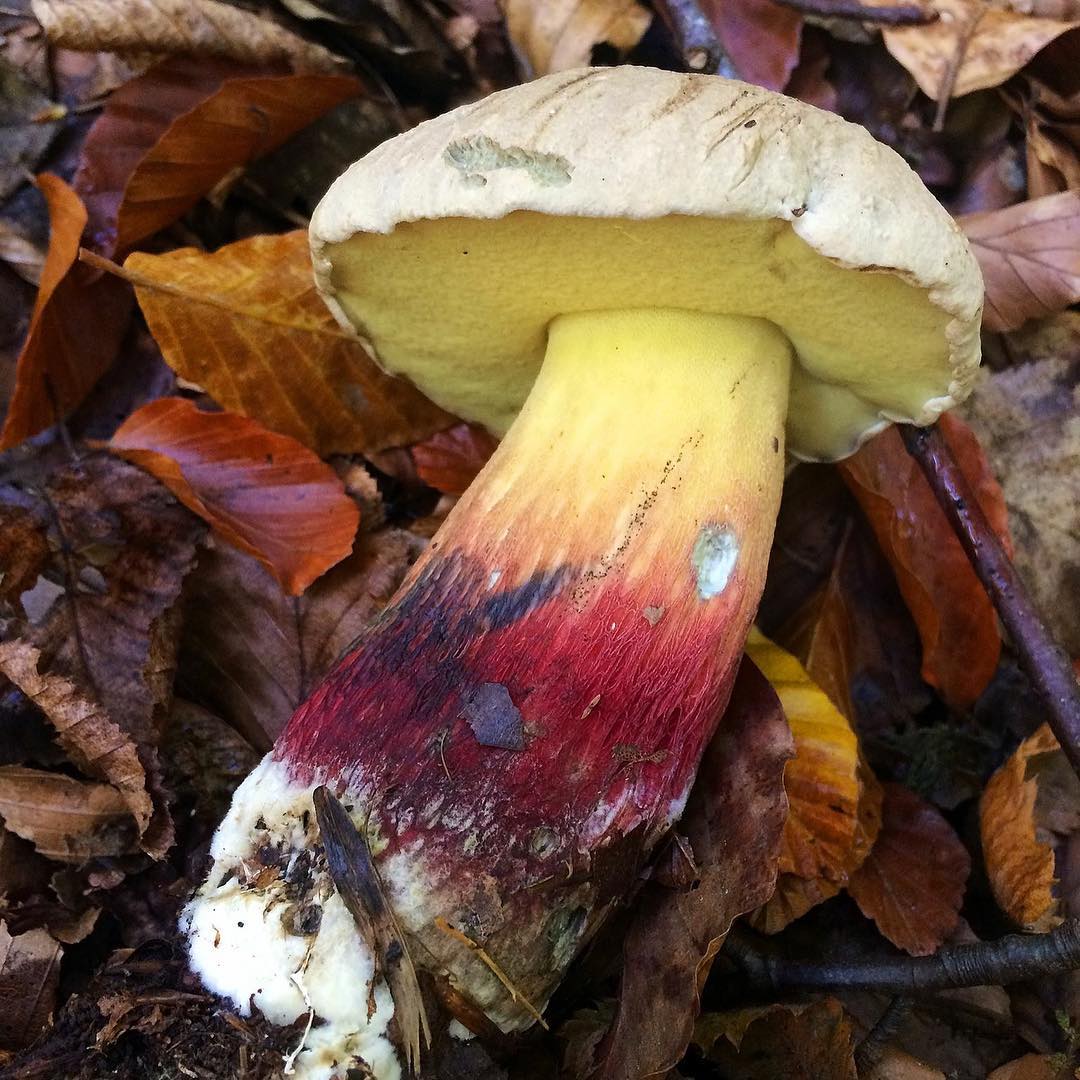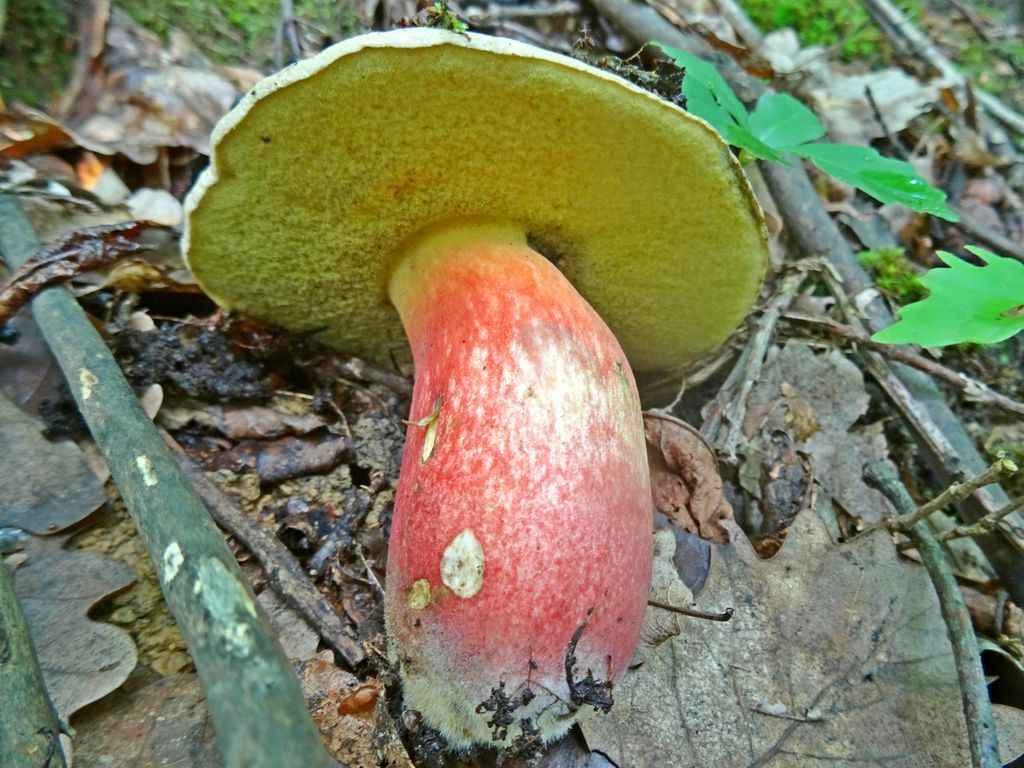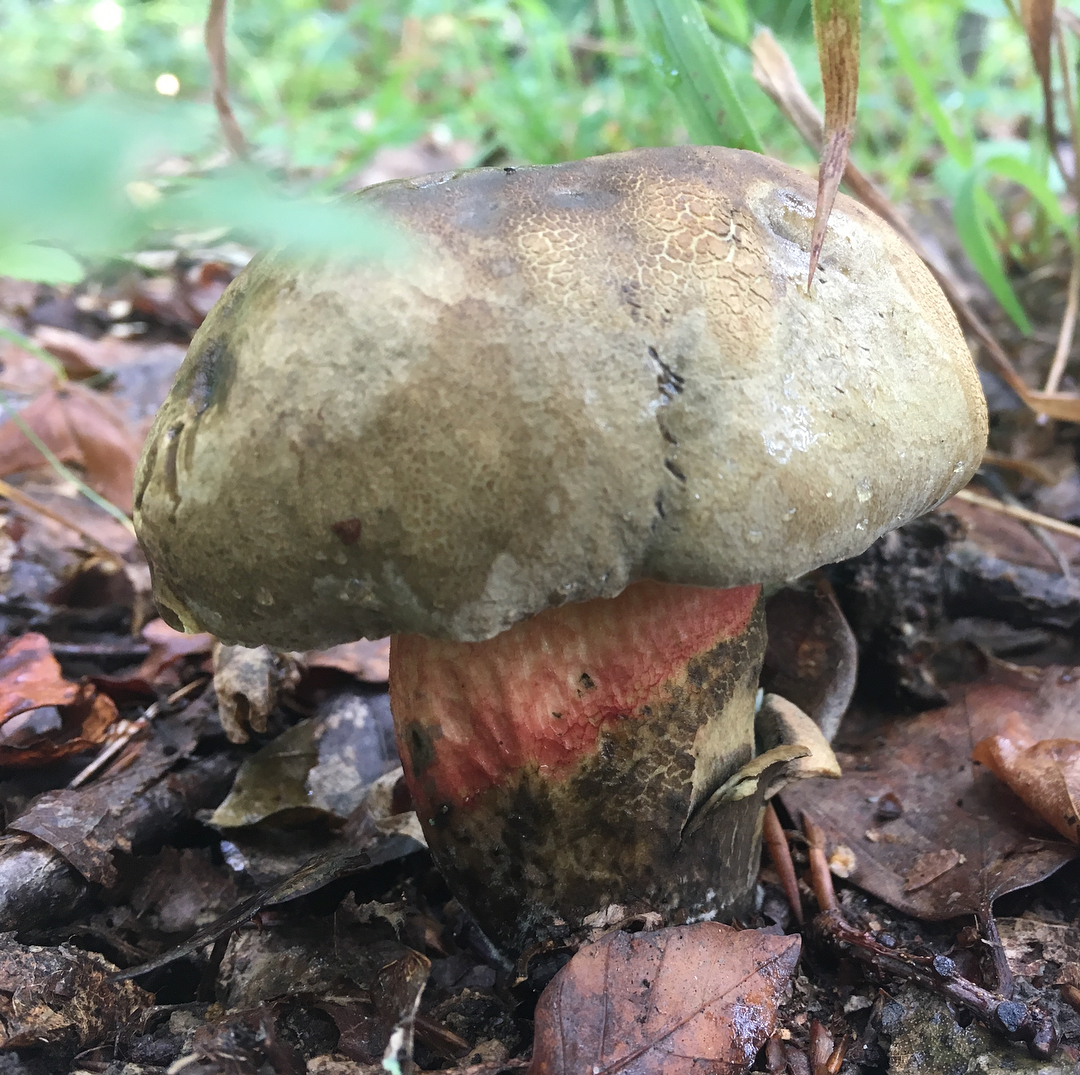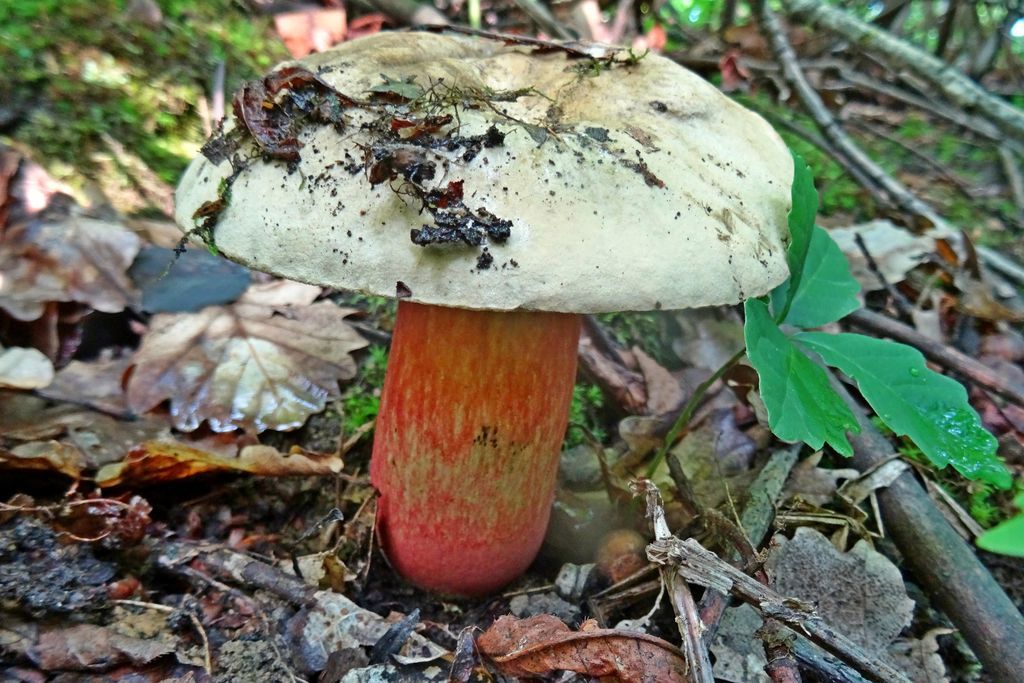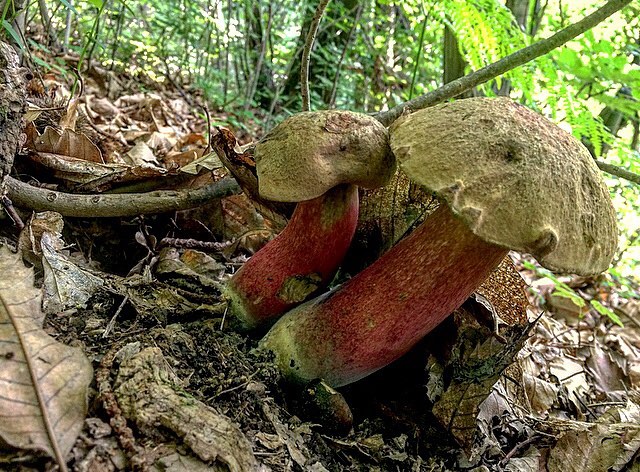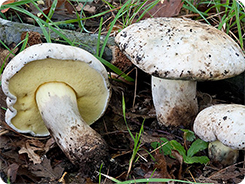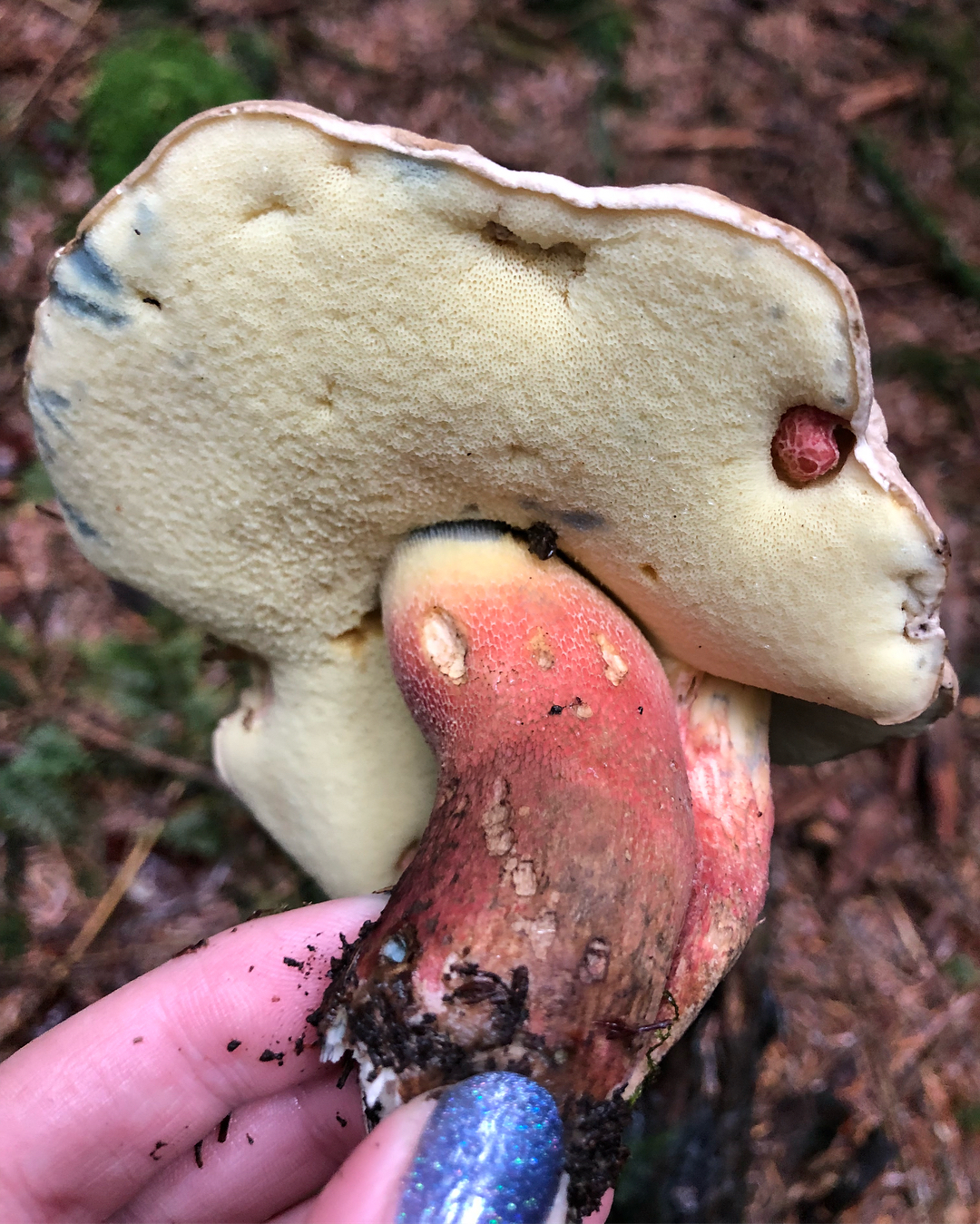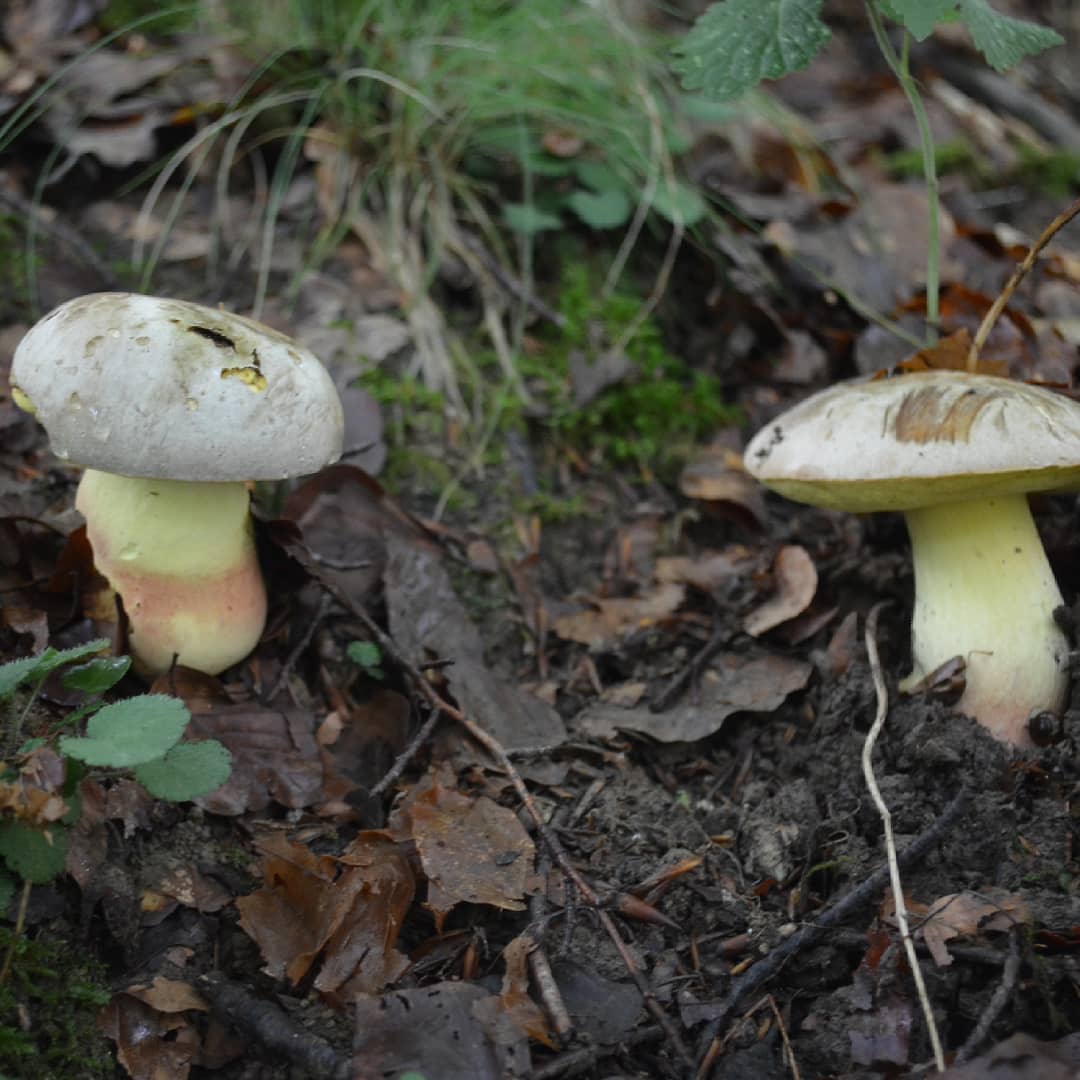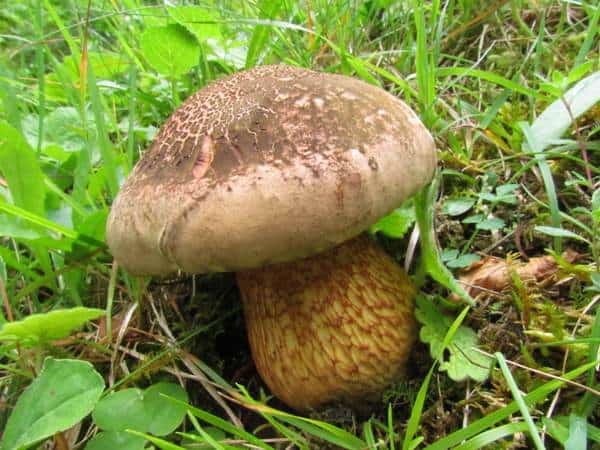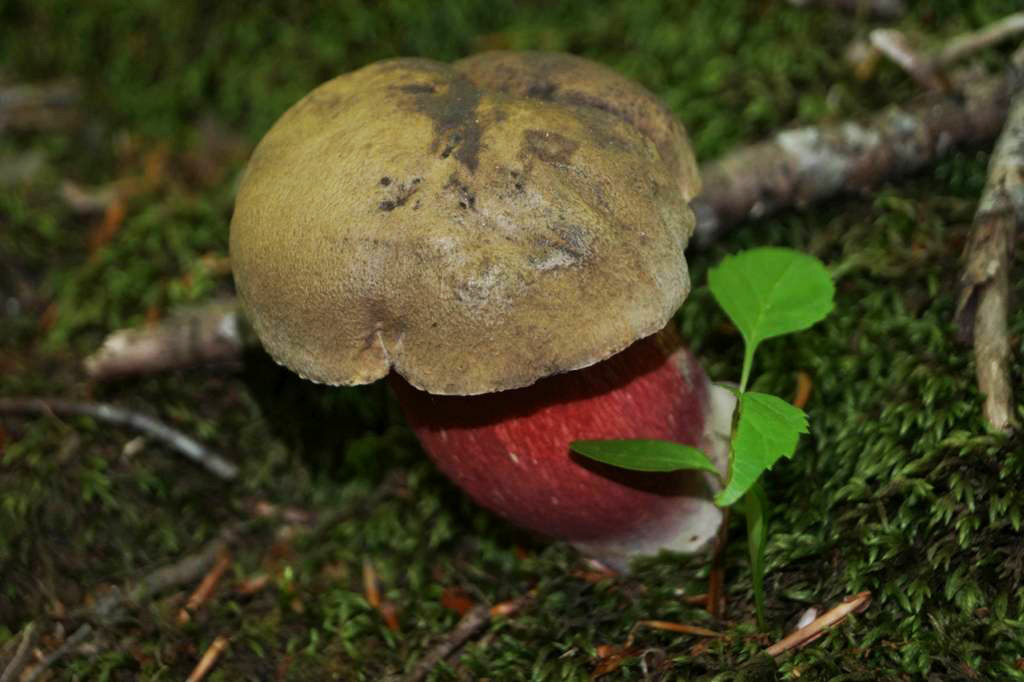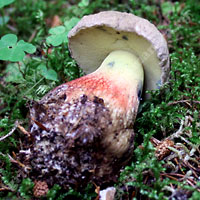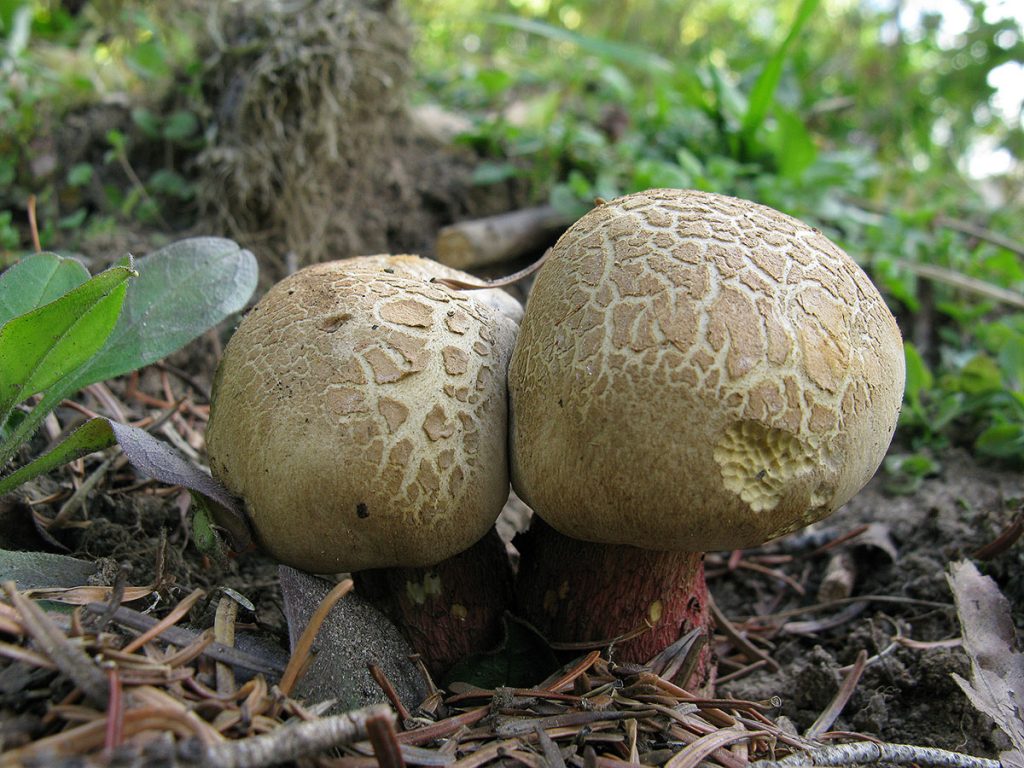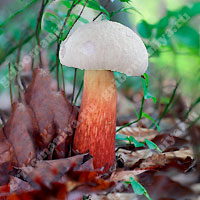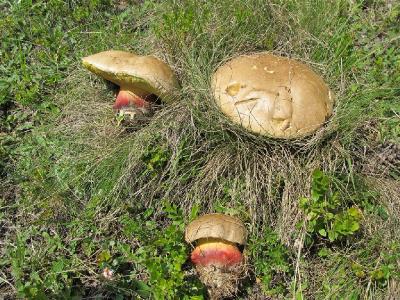Description and characteristics of the inedible mushroom
This type of Caloboletus radicans (Boletus rooted) belongs to the genus Caloboletus (Kalobolet), the Boletaceae family. Has other names: Boletus stocky, Boletus deeply rooted, Boletus bitter spongy, Boletus rooting, Boletus bitter spongy. Latin name - Boletus radicans caloboletus radicans.
The cap reaches a diameter of 6–20 cm, sometimes it grows up to 30 cm. The shape of this part in young mushrooms is hemispherical, as it grows it becomes convex or cushion-shaped, the edges are first bent, then become straightened, wavy. The skin on the cap is smooth, dry, and is characterized by a white with fawn, gray, sometimes greenish tint. When pressed, it tends to turn blue.
The hymenophore (lower part of the cap) is tubular. The tubules are lemon yellow, becoming olive yellow with age. Also turn blue in the cut. The pores are round, small, of the same lemon-yellow color.
The flesh on the cut is dense, milky-blue, turns blue when cut or broken. Her smell is pleasant, but the taste is bitter.
The height of the leg is 5–8 cm, sometimes it grows up to 13 cm, the diameter is 3–5 cm. The shape of this part of the fungus is tuberous-swollen. The color in the upper segment is lemon-yellow, with brownish-olive or bluish spots at the base. Above, you can see a highly visible mesh. On the cut, the leg turns blue, and at the base it takes on a reddish tint.
Mushroom species
The genus Boletus (Borovik) includes many both edible and inedible species, among which there are white, fine, bronze, beautiful-legged and other varieties. Both a rooted or whitish mushroom and species b. beautiful and b. lovely belong to inedible.
- White mushroom: edible species. The color of the cap corresponds to the name, but it can also be dark. Its diameter can reach 26 cm in the presence of favorable conditions for development, its surface is dry and velvety to the touch. The pulp is light and dense, does not change color and has no odor. The leg is up to 18 cm long, has a cylindrical shape. The spore powder is brown-olive.
- Bronze boletus: edible. The pulp softens with age, has a homogeneous structure, darkens noticeably on the cut, has a weak taste and aroma. The height of the leg is small.
- Semi-white mushroom, or yellow boletus: edible mushroom, the color of the pulp does not change on the cut. It has a characteristic, albeit mild, carbolic acid odor at the base of the stem. In diameter, the cap grows to 22 cm, the shape varies from rounded and convex to flat and rising.
- Boletus is beautiful: species included in the category of inedible. The diameter of the cap ranges from 8 to 30 cm, its shape is hemispherical, the surface is woolly. The color ranges from red to olive brown. The pulp is yellowish, noticeably blue on the cut. The height of the leg is up to 15 cm, its diameter is up to 7 cm maximum. The leg is rough to the touch, the base is covered with a small pile. This mushroom is used in cooking for pickling.
- Boletus boletus is a representative of the group of inedible mushrooms. He has a light brown or brownish-olive upper part of the cap, its surface is wrinkled, the edge is wavy. The pulp is light and dense, turns blue when damaged. The tubules on the lower surface are yellow; on the cut they acquire a blue color. The length of the leg is up to 15 cm. This inedible mushroom grows on soils with high acidity, its upper part reaches 16 cm, the shape resembles a half of a ball, but it changes with age. The covering tissue is different to the touch. Its color is brownish-olive or brownish-gray. The leg is dense, towards the base it acquires a red tint.

The boletus has many edible and inedible species.
- Boletus wolf, or false satanic: it is referred to as conditionally edible mushrooms. It is characterized by a hat with a diameter of 10 to 20 cm. In young representatives, it is semicircular, with age it becomes prostrate. The covering tissue has a red or pink tint.Young specimens are light, with aging they noticeably darken within the limits of their color. The skin is dry, there is a felt coating on top. The pulp is light yellowish, which the boletus also possesses, and has a dense structure. The leg is cylindrical, only up to 8 cm long, therefore it is considered short. The surface of the leg is bright yellow and tapered at the bottom.
- Golden boletus: referred to as edible mushrooms, representatives of the species have a slightly smaller cap than the above-described species, but its shape changes from convex to almost flat. At a young age, its skin is smooth and velvety; as it ages, it cracks noticeably. The hymenophore is also yellow tubules. The color hardly changes when touched. The length of the tubules is no more than 3 cm. The length of the stem reaches 25 cm, it is narrowed at the top. This part of the fungus is thin and resilient, with a typical reticular pattern.
Description of the painful leg pain
The cap of this mushroom is olive-gray, brown, light brown or gray-brown. The surface of the cap is usually smooth, but occasionally there may be wrinkles. At a young age, the caps are dry, dull, slightly wavy, and with age they become naked. The shape of the pain of the beautiful leg grows from semicircular to convex with a wavy, wrapped edge. The diameter of the cap is 4-15 centimeters.
The tubules are lemon yellow at first, and with age they turn olive yellow. On the cut, the tubes turn blue. Their length ranges from 3 to 16 centimeters. At the stem, the tubes can be both free and notched. The pores are small, rounded, their color is initially gray-yellow, and over time it becomes lemon yellow, and even later a greenish tint appears. When pressed, the pores turn blue. Spores are smooth, ellipsoid-fusiform, ocher color. Spore powder of brownish-olive color.
In young inedible boletus, the legs are barrel-shaped, after which they become cylindrical or clavate, the base can sometimes be pointed.

The leg height ranges from 3 to 15 centimeters, and the thickness is 1-4 centimeters. The upper part of the leg is lemon-yellow with a fine white mesh, the middle part of the leg is carmine-red with a clear red mesh, below the leg is brown-red, and at the very base it is white. In adult specimens, the red color may fade over time.
The flesh of a beautiful leg pain is dense and tough. The color of the pulp is light cream or whitish. On the cut, the pulp turns blue in some places, mainly in the upper part of the leg and in the cap. The taste of the pulp is at first sweetish, and after that it is too bitter; the pulp does not have a special smell.
Areas of growth of inedible pains
Beautiful-legged painters grow in coniferous forests. They choose mountainous areas, and there they settle under the fir trees. Rarely, inedible pains are found in deciduous forests. They grow on the soil. Fruiting from July to October.

Description
The yellowish pores turn blue when injured.
Up to 15 cm (6 in) or rarely 20 cm (8 in) in diameter, the cap is beige to olive and initially globular before opening out to a hemispherical and then convex shape. The surface of the cap is smooth or has minute hairs, and sometimes develops cracks with age. The cap cuticle hangs over the cap margin. The pore surface is initially pale yellow before deepening to an olive-yellow in maturity, and quickly turns blue when it is injured. The pores, numbering one or two per millimeter, are circular when young but become more angular as the mushroom ages. The tubes are up to 2 cm (0.8 in) deep.
The attractively colored stipe is typically yellow above to pink-red below, with a straw-colored network (reticulation) near the top or over the upper half; occasionally the entire stipe is reddish. It measures 7-15 cm (2.8-5.9 in) long by 2-5 cm (0.8-2.0 in) thick, and is either fairly equal in width throughout, or thicker towards the base. Sometimes, the reddish stipe color of mature mushrooms or harvested specimens that are a few days old disappears completely, and is replaced with ocher-brown tones. The pale yellow flesh stains blue when broken, the discolouration spreading out from the damaged area. Its smell can be strong, and has been likened to ink. The spore print is olive to olive-brown. Spores are smooth and elliptical, measuring 13–19 by 5–6 µm. The basidia (spore-bearing cells) are club-shaped, four-spored, and measure 30–38 by 9–12 µm. The cystidia are club-shaped to spindle-shaped, hyaline, and measure 25–40 by 10–15 µm.
Variety frustosus is morphologically similar to the main type, but its cap becomes areolate (marked out into small areas by cracks and crevices) in maturity. Its spores are slightly smaller too, measuring 11–15 by 4–5.5 µm. In the European form ereticulatus, the reticulations on the upper stipe are replaced with fine reddish granules, while the variety ruforubraporus has pinkish-red pores.
Description of the bronze bolt
The diameter of the cap of this large mushroom is 7-17 centimeters, but there are huge specimens, the caps of which reach 40 centimeters in diameter. In this case, the thickness of the cap is 2-4 centimeters. The shape of the cap at a young age is convex, almost spherical, but over time it becomes prostrate. The surface of the caps in young fruit bodies is smoother, but later dimples and depressions appear, they are located irregularly, and become more numerous towards the edge.
The color of the caps of young mushrooms is dark chestnut and even almost black, while there are areas with a whitish bloom. Such zones are the main distinguishing feature of the bronze bolt. With age, the caps become lighter, the color changes in spots and becomes copper-brown or intense chestnut. In young mushrooms, the edges of the caps are uneven, but over time they straighten. The surface of the cap is not slimy even in wet weather.
The tubules are adherent to the stem. The color of the tubules is white or gray-white, but with age it becomes creamy or pale yellow, and then completely yellow-olive. When pressed on the tubes, they darken. The pores are angular, 3 by 1 millimeter in size. The spores are fusiform, thin-walled, smooth, with one or more drops of fat. The color of the spores is pale ocher, spore powder of olive brown color.

The leg is 9-12 centimeters long and 2-4 centimeters thick. The shape of the leg is clavate or tuberous; in adulthood, it becomes cylindrical. The surface of the leg is slightly wrinkled. The leg is rigid in structure. Its color varies from light pink-beige to olive-beige, at a young age, the legs can be almost white. The upper part of the leg is mesh white, and the lower part of the leg is almost brown.
The flesh of the caps in young specimens is homogeneous, tough, wine-colored. With age, the pulp becomes softer and turns pale to white, but above the tubes it retains a yellowish tint. The flesh of the leg is homogeneous, darkens at the break. The smell and taste of the pulp are soft.
Spreading pains of bronze
These are rare mushrooms, they grow in mixed forests. They give preference to humus moist soils. Bronze paints are widespread mainly in the south of our country. They bear fruit in summer and early autumn.

Similarities between bronze paints and other mushrooms
The Polish mushroom looks somewhat similar to the bronze pain, these mushrooms can be confused by beginners. But on the leg of the Polish mushroom there is no mesh, and the flesh on the cut may turn blue.
White pine mushroom, which is considered to be of very high quality, can also be confused with bronze pain. But porcini pine mushrooms are more common, they differ in caps of brown-red or wine-red color and are larger in size. In addition, porcini pine mushrooms live exclusively in coniferous forests.
The semi-bronze boletus can also be confused with a relative, but it has a lighter color cap and grows in mixed and deciduous forests.
Description
Hat
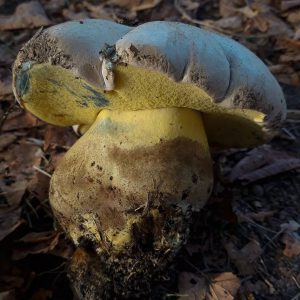
The skin of the mushroom is dry, velvety-smooth, it is difficult to separate from the pulp.
The color of the cap is whitish with various shades - grayish, fawn, bluish, greenish. When you press on the cap, a blue spot appears.
Spore-bearing layer
Tubular. The stomata of the tubular layer are small, the tubular layer itself is colored yellow; as the fungus ages, it becomes olive yellow. Closer to the pedicle, the hymenophore becomes depressed. When pressed or cut, the tubular layer of boletus rooting turns blue. Spore powder brown with olive tint.
Pulp
In the cap, the flesh is thick, dense, the young mushroom is quite firm. It turns blue at a break or cut, tastes sweet, smells pleasant, after a while strong bitterness begins to be felt. The flesh of the leg is dense, fibrous, turns blue in places of fracture or incision, and becomes reddish at the base.
[edit] Literature
Categories: See also: Fighting (order)
| Boletovye | ||||||||||||||||||||
|---|---|---|---|---|---|---|---|---|---|---|---|---|---|---|---|---|---|---|---|---|
|
||||||||||||||||||||
| Scientific classification | ||||||||||||||||||||
intermediate ranks
|
||||||||||||||||||||
| International scientific name | ||||||||||||||||||||
|
BoletaceaeChevall., 1828 |
||||||||||||||||||||
| Childbirth | ||||||||||||||||||||
|
||||||||||||||||||||
|
Painful (Latin Boletaceae) - a family of fungi, characterized primarily by a porous hymenophore.
Beautiful leg boletus: where it grows, what it looks like, edibility, how to distinguish it, photo

Boletus boletus (lat.Caloboletus calopus or Boletus calopus), also beautiful or inedible boletus is a fairly common mushroom, which is distinguished by a bright color of the leg. As the name of the species suggests, fruit bodies cannot be eaten.
What beautiful leg pains look like
The cap of the beautiful-legged painter can grow up to 6-14 cm in diameter, while in appearance it is completely inconspicuous, which contrasts strongly with the bright leg of the mushroom.
Its color ranges from grayish olive to light brown. The hat is smooth to the touch, but matte and dry.
In young specimens, it has the shape of a hemisphere, however, in mature pains it opens and becomes convex. The edges of the cap turn downward as the fruiting body grows.
On cut, this species turns blue within 5-8 minutes.
The spores of the fungus are brownish-olive.
The leg of the bolt is shaped like a barrel in young mushrooms. At the next stage of development, it becomes clavate, and in mature specimens it acquires a cylindrical appearance. The height of the leg is on average 5-15 cm, the diameter is 2-5 cm. Under the head itself, it is whitish-yellow, but this color quickly turns into a rich red. In mature pains, the leg is brownish in the lower part.
Important! One of the hallmarks of a beautiful leg pain is the presence of a fine mesh of whitish or light yellow color, which covers almost the entire leg. The pulp of the fruit bodies is quite dense, even firm
It is painted in cream shades and does not have a pronounced odor.
The pulp of the fruit bodies is quite dense, even firm. It is painted in cream shades and does not have a pronounced odor.
Where beautiful-leg pains grow
The distribution area of the beautiful-legged bole includes the coniferous forests of the mountainous regions. Most often, small groups of mushrooms can be found near spruce trees. Singles are rarely found in deciduous and mixed forests.
The preferred type of soil is sandy with a high level of acidity. On the territory of Russia, the beautiful-legged sore grows in the southern latitudes.
Important! The fruiting period is July-October. In warmer years, it lasts until November.
Boletus boletus is an inedible mushroom, however, the reasons for this definition can vary greatly in the reference literature. Some authors note that its pulp does not contain toxic substances, but it cannot be eaten because of its strong bitterness. The sharp unpleasant aftertaste does not disappear even after 10 hours of soaking or frying.
In other sources, it is argued that the beautiful leg is sick is poisonous. Toxic components in its pulp can cause severe intestinal upset, cramps and even loss of consciousness. After some time, the victim begins to cirrhosis of the liver.
Sometimes there are white streaks on the lower part of the leg (near the ground)
Important! The boletus boletus is similar to the satanic boletus - a very poisonous mushroom. They are distinguished mainly by disputes - in the satanic mushroom, they have a rich red color.
They are distinguished mainly by disputes - in the satanic mushroom, they are of a deep red color.
Poisoning symptoms
The first signs of poisoning begin to appear within 2-3 hours after eating fruit chalk. The characteristic symptoms include the following changes:
- causeless weakness, trembling hands;
- dizziness;
- nausea, vomiting;
- diarrhea (sometimes bloody);
- Strong headache;
- convulsions;
- muscle pain.
If a large amount of toxic substances have entered the body, this can lead to loss of consciousness.
Important! Another symptom of poisoning with beautiful leg pain appears after 1-2 weeks - by this time, toxins that have entered the human body begin to destroy liver cells. If first aid is not provided on time, poisoning can lead to cirrhosis.
It is also necessary to artificially induce vomiting in the victim - for this he is given a glass of soda solution diluted in a proportion of 1 tsp. for 0.5 liters of water.
Conclusion
Despite its attractive appearance, it is impossible to collect a beautiful-legged sore - the mushroom is one of the inedible and even poisonous, according to some sources. Different authors have different opinions about the toxicity of this pain, however, everyone notes strong bitterness in the pulp of fruit bodies. It is impossible to get rid of it even after prolonged soaking and heat treatment.
The danger of pain in the beautiful-legged is also that an inexperienced mushroom picker can confuse some edible varieties with it. At the slightest suspicion that the find is a poisonous mushroom, it should be left alone.
In addition, you can find out how a beautiful-legged one looks like in the video below:
[edit] Classification
List of species according to the site "Catalog of Life":
| Cat. | Latin name | Russian name | author | |||||||||
|---|---|---|---|---|---|---|---|---|---|---|---|---|
| Boletus aereus | Copper porcini mushroom | Bull. 1789 | ||||||||||
| Boletus appendiculatus | Borovik girlish | Schaeff. 1763 | ||||||||||
| Boletus armeniacus | Quél. 1884 | |||||||||||
| Boletus badius | Polish mushroom | (Fr.) Fr. 1832 | ||||||||||
| Boletus betulicola | Birch mushroom | (Vassilkov) Pilát & Dermek 1974 | ||||||||||
| Boletus brunneus | Cooke & Massee 1891 | |||||||||||
| Boletus byssinus | Schrad. 1794 | |||||||||||
| Boletus calopus | Boletus is beautiful | Pers. 1801 | ||||||||||
| Boletus caucasicus | Singer ex Alessio 1985 | |||||||||||
| Boletus chrysenteron | Bull. 1791 | |||||||||||
| Boletus cinnabarinus | Wahlenb. 1812 | |||||||||||
| Boletus cisalpinus | (Simonini, H. Ladurner & Peintner) Watling & A.E. Hills 2004 | |||||||||||
| Boletus cookei | Sacc. & P. Syd. 1899 | |||||||||||
| Boletus declivitatum | (C. Martín) Watling 2004 | |||||||||||
| Boletus edulis | White mushroom | Bull. 1782 | ||||||||||
| Boletus fechtneri | Borovik Fechtner | Velen. 1922 | ||||||||||
| Boletus ferrugineus | Schaeff. 1762 | |||||||||||
| Boletus flavus | With. 1796 | |||||||||||
| Boletus fragrans | Vittad. 1835 | |||||||||||
| Boletus fuligineus | Fr. & Hök 1836 | |||||||||||
| Boletus impolitus | Boletus semi-white, semi-white mushroom | Fr. 1838 | ||||||||||
| Boletus legaliae | Borovik le Gal, Borovik legal | Pilát 1968 | ||||||||||
| Boletus leptospermi | McNabb 1968 | |||||||||||
| Boletus lignatilis | Berk. & M. A. Curtis 1868 | |||||||||||
| Boletus luridiformis | Boletus poddubikovy | Rostk. 1844 | ||||||||||
| Boletus luridus | Olive brown oak tree | Schaeff. 1774 | ||||||||||
| Boletus megalosporus | Berk. 1859 | |||||||||||
| Boletus moravicus | Vacek 1946 | |||||||||||
| Boletus nigricans | Pat. & C.F. Baker 1918 | |||||||||||
| Boletus novae-zelandiae | McNabb 1968 | |||||||||||
| Boletus obscuratus | (Singer) J. Blum 1969 | |||||||||||
| Boletus paluster | Peck 1872 | |||||||||||
| Boletus paradisiacus | R. Heim 1951 | |||||||||||
| Boletus persoonii | Bon 1988 | |||||||||||
| Boletus pinicola | Pine mushroom | Rea 1922 | ||||||||||
| Boletus pinophilus | Pilát & Dermek 1973 | |||||||||||
| Boletus porosporus | Porous boletus | Imler ex Bon & G. Moreno 1977 | ||||||||||
| Boletus pruinatus | Fr. & Hök 1835 | |||||||||||
| Boletus pseudoregius | (Heinr. Huber) Estadès 1988 | |||||||||||
| Boletus pseudosulphureus | Kallenb. 1923 | |||||||||||
| Boletus pulverulentus | Powdered boletus | Opat. 1836 | ||||||||||
| Boletus queletii | Schulzer 1885 | |||||||||||
| Boletus radicans | Boletus is stocky | Pers. 1801 | ||||||||||
| Boletus rawlingsii | McNabb 1968 | |||||||||||
| Boletus regius | Boletus royal | Krombh. 1832 | ||||||||||
| Boletus reticulatus | Boletus mesh | Schaeff. 1774 | ||||||||||
| Boletus reticuloceps | (M. Zang, M.S. Yuan & M.Q. Gong) Q.B. Wang & Y.J. Yao 2005 | |||||||||||
| Boletus rhodopurpureus | Boletus pink-purple | Smotl. 1952 | ||||||||||
| Boletus ripariellus | (Redeuilh) Watling & A.E. Hills 2004 | |||||||||||
| Boletus roseoalbidus | (Alessio & Littini) G. Moreno & Heykoop | |||||||||||
| Boletus rubellus | Red flywheel, reddish boletus | Krombh. 1836 | ||||||||||
| Boletus satanas | Satanic mushroom | Lenz 1831 | ||||||||||
| Boletus speciosus | Frost 1874 | |||||||||||
| Boletus subappendiculatus | Dermek, Lazebn. & J. Veselský 1979 | |||||||||||
| Boletus subtomentosus | Mosswheel green | L. 1753 | ||||||||||
| Boletus torosus | Fr. & Hök 1835 | |||||||||||
| Boletus xanthocyaneus | (Ramain) Romagn. 1976 | |||||||||||
|
[edit] Application
Many boletus are edible mushrooms with high nutritional qualities. They are eaten fresh or canned, but they are rarely salted compared to other mushrooms.
Due to the fact that the overwhelming majority of species are mycorrhizal formers, their artificial cultivation is unprofitable. The exception is made by several representatives of the moss, which grow on wood, and from which fruit bodies were obtained in culture. The growth of spores of painful in cultural conditions is achieved with great difficulty, sometimes with the help of yeast or bacteria.
The family includes a number of species that are inedible for various reasons (the most famous among them is the gall fungus (Tylopilus felleus)), as well as conditionally edible, for example, speckled oak tree (Boletus erythropus). Apparently, there are no highly poisonous mushrooms among the boletuses. Satanic mushroom can be called poisonous (Boletus satanas), recently often considered conditionally edible.
It is good to collect boletae for inexperienced mushroom pickers, since representatives of this family are almost impossible to confuse with poisonous agaric.
Similar species
Xerocomellus chrysenteron has a non-reticulated stipe.
Caloboletus inedulis is smaller with a lighter-colored cap.
The overall color of Caloboletus calopus, with its pale cap, yellow pores and red stipe, is not shared with any other bolete. Large pale specimens resemble Suillellus luridus, and the cap of Rubroboletus satanas is a similar color but this species has red pores. Fruit bodies in poor condition could be confused with Xerocomellus chrysenteron but the stipes of this species are not reticulated. Edible species such as B. edulis lack a red stipe. It closely resembles the similarly inedible C. radicans, which lacks the redness on the stipe. Like C. calopus, the western North American species C. rubripes also has a bitter taste, similarly colored cap, and yellowish pores that bruise blue, but it lacks reticulation on its reddish stipe. Found in northwestern North America, B. coniferarum lacks reddish or pinkish color in its yellow reticulate stipe, and has a darker, olive-gray to deep brown cap.
Two eastern North American species, C. inedulis and C. roseipes, also have an appearance similar to C. calopus. C. inedulis produces smaller fruit bodies with a white to greyish-white cap, while C. roseipes associates solely with hemlock.C. firmus, found in the eastern United States, eastern Canada, and Costa Rica, has a pallid cap color, reddish stipe, and bitter taste, but unlike C. calopus, has red pores and lacks stipe reticulation.C. panniformis, a Japanese species described as new to science in 2013, bears a resemblance to C. calopus, but can be distinguished by its rough cap surface, or microscopically by the amyloid-staining cells in the flesh of the cap, and morphologically distinct cystidia on the stipe.
Distribution and habitat
An ectomycorrhizal species,Caloboletus calopus grows in coniferous and deciduous woodland, often at higher altitudes, especially under beech and oak. Fruit bodies occur singly or in large groups. The species grows on chalky ground from July to December, in Northern Europe, and North America's Pacific Northwest and Michigan. In North America, its range extends south to Mexico. Variety frustosus is known from California and the Rocky Mountains of Idaho. In 1968, after comparing European and North American collections, Miller and Watling suggested that the typical form of C. calopus does not occur in the United States. Similar comparisons by other authors have led them to the opposite conclusion, and the species has since been included in several North American field guides. The bolete has been recorded from the Black Sea region in Turkey, from under Populus ciliata and Abies pindrow in Rawalpindi and Nathia Gali in Pakistan, Yunnan Province in China, Korea, and Taiwan.
Biochemistry
 Structure of calopin.
Structure of calopin.
Although it is an attractive-looking bolete, Caloboletus calopus is not considered edible on account of its very bitter taste, which does not disappear upon cooking. There are reports of it being eaten in far eastern Russia and Ukraine. The bitter taste is largely due to the compounds calopin and a δ-lactone derivative, O-acetylcyclocalopin A. These compounds contains a structural motif known as a 3-methylcatechol unit, which is rare in natural products. A total synthesis of calopin was reported in 2003.
The pulvinic acid derivatives atromentic acid, variegatic acid, and xerocomic acid are present in B. calopus mushrooms. These compounds inhibit cytochrome P450 — major enzymes involved in drug metabolism and bioactivation. Other compounds found in the fruit bodies include calopin B, and the sesquiterpenoid compounds cyclopinol and boletunones A and B. The latter two highly oxygenated compounds have significant free-radical scavenging activity in vitro... The compounds 3-octanone (47.0% of total volatile compounds), 3-octanol (27.0%), 1-octen-3-ol (15.0%), and limonene (3.6%) are the predominant volatile components that give the fruit body its odour.
Taxonomy
Caloboletus calopus was originally published under the name Boletus olivaceus by Jacob Christian Schäffer in 1774, but this name is unavailable for use as it was later sanctioned for another species. Johann Friedrich Gmelin's 1792 synonym Boletus lapidum is also illegitimate. Christiaan Hendrik Persoon described the mushroom in 1801; its specific name is derived from the Greek καλος / kalos ("Pretty") and πους / pous ("Foot"), referring to its brightly colored stipe. The German name, Schönfußröhrling or "pretty-foot bolete", is a literal translation. Alternate common names are scarlet-stemmed bolete and bitter beech bolete.
Other synonyms include binomials resulting from generic transfers to Dictyopus by Lucien Quélet in 1886, and Tubiporus by René Maire in 1937.Boletus frustosus, originally published as a distinct species by Wally Snell and Esther Dick in 1941, was later described as a variety of B. calopus by Orson K. Miller and Roy Watling in 1968. Estadès and Lannoy described the variety ruforubraporus and the form ereticulatus from Europe in 2001.
In his 1986 infrageneric classification of the genus Boletus, Rolf Singer placed C. calopus as the type species of the section Calopodes, which includes species characterized by having a whitish to yellowish flesh, bitter taste, and a blue staining reaction in the tube walls. Other species in section Calopodes include C. radicans, C. inedulis, B. peckii, and B. pallidus.Genetic analysis published in 2013 showed that C. calopus and many (but not all) red-pored boletes were part of a dupainii clade (named for Boletus (nowRubroboletus) dupainii), well-removed from the core group of the type species B. edulis and relatives within the Boletineae. This indicated it needed placement in a new genus. This took place in 2014, B. calopus was transferred to (and designated the type species of) the new genus Caloboletus by Italian mycologist Alfredo Vizzini.
[edit] Ecology
Leccinum scabrum
They grow mainly on the soil in forests, less often in the tundra, on wood and on other fungi (parasites). Most of the species enter mycorrhiza with various trees, often systematically distant from each other (for example, with conifers and flowering trees). However, a fungus of one kind or another is usually confined to trees of one or more genera. They are also found in artificial forest plantations, sometimes very far from the boundaries of their natural range. For the growth of boletae, in addition to the necessary trees, the type of soil, its moisture content and acidity play an important role.
In terms of their geographical distribution, boletes are cosmopolitan; they are common on all continents, with the exception of Antarctica. The area of the overwhelming majority of species covers the temperate latitudes of Eurasia and North America. They can also be found in the tundra zone, tropics and temperate regions of the Southern Hemisphere.


